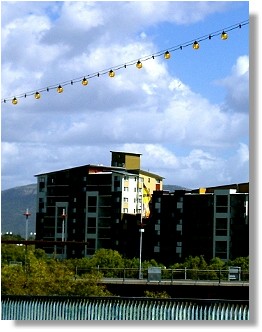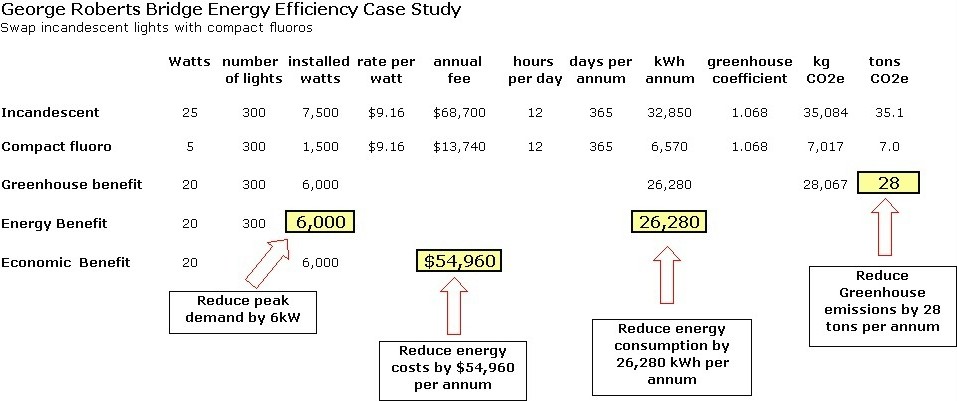Watts
Going Down, |
| Assumptions - Case Study Results - Link to Spread Sheet |

|
|
Townsville City Councils Citiworks Business Unit are saving energy and have reduced greenhouse gas emissions through the simple act of replacing incandescent light globes with compact fluorescent (link to Tip 3- Seven Sustainable Tips for Everyone). Not only have Citiworks cut energy costs by 80%, but their maintenance costs have fallen dramatically due to the long life of compact fluorescents, and the reduced maintenance costs associated with removing entire strands of incandescent lights. |
 |
The original 25W incandescent lights were first put up on George Roberts Bridge before 2000. The lights had a life span of about 3 months, and would be bulk-changed once a proportion had blown. Replacing the incandescent lights incurred a maintenance costs of about $1,500 roughly every 4 months due to road closure and traffic signage requirements plus costs of about $2.25 per globe. Citiworks critically appraised the system being used and sought alternatives to reduce energy and costs. From this, they decided to install compact fluorescent globes that had previously been used in Flinders St East, but were no longer required due to the lighting upgrade of the street. The 5W compact fluorescent globes, that are surrounded by a yellow sphere for added protection from the elements, were installed on the bridge during Christmas 2004. |
Whereas the incandescent globes failed after three to six months operation, and then required to be bulk-changed, the compact fluorescent lights, which had been in operation in Flinders St East since August 2001, are still largely in operation over three years later. Not only do the new lights have a longer life span, only the blown bulbs have to be changed, thereby saving costs through a reduced need for signage and road closures. Benefits:
The lights on George Roberts Bridge are on unmetered supply and the energy cost for these lights is determined by the Queensland Government and specified in the Queensland Government Gazette. It is believed that these lights are categorised as Rate 3 in which case the cost to Main Roads is $9.16 per installed watt. The economic and other benefits associated with this initiative have been modelled in a spread sheet and the information is available here. |
| Draft Assumptions | |||
| Incandescent |
Fluro |
||
| number of lights | 300 |
300 |
|
| wattage | 25 |
5 |
|
| per watt fee | $9.16 |
$9.16 |
|
| total annual energy fee | $68,700.00 |
$13,740.00 |
|
| purchase cost each | $2.25 |
$8.50 |
|
| setup traffic fee | $1,500.00 |
$1,500.00 |
|
| replacement traffic fee | $1,500.00 |
$1,500.00 |
|
| annual traffic fee | $4,500.00 |
$0.00 |
|
| cost for 300 globes | $675.00 |
$2,550.00 |
|
| annual replacements | 3 |
0.3 |
|
| annual replacement cost | $2,025.00 |
$765.00 |
|
| setup | $2,175.00 |
$4,050.00 |
|
| run | $75,225.00 |
$14,505.00 |
